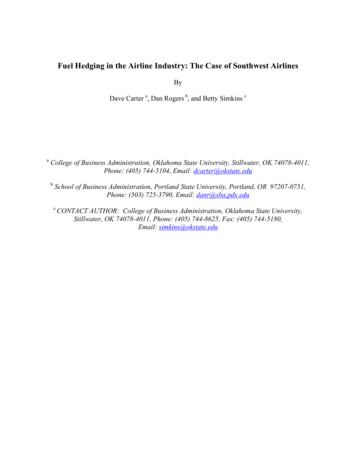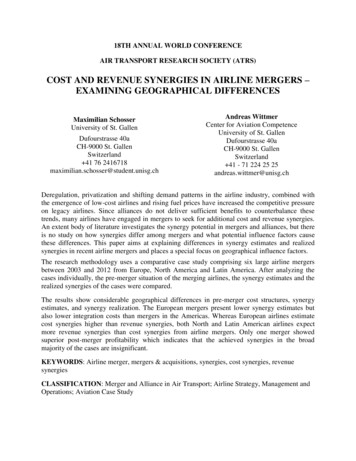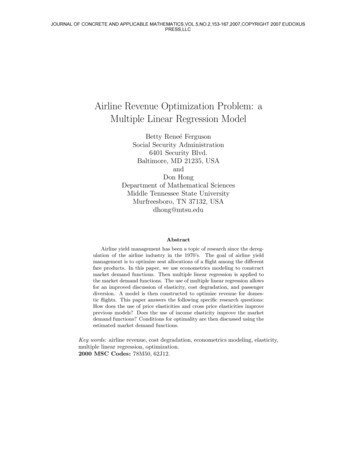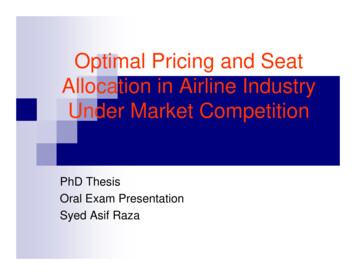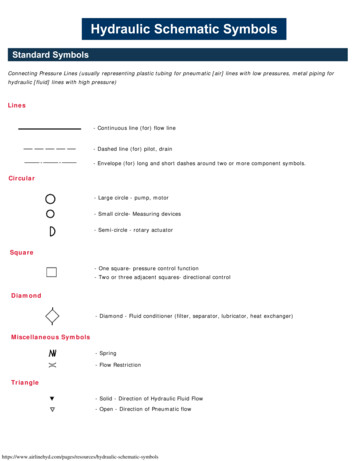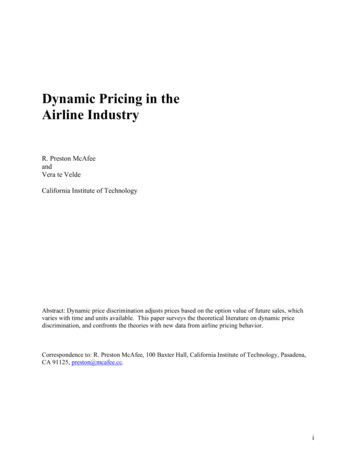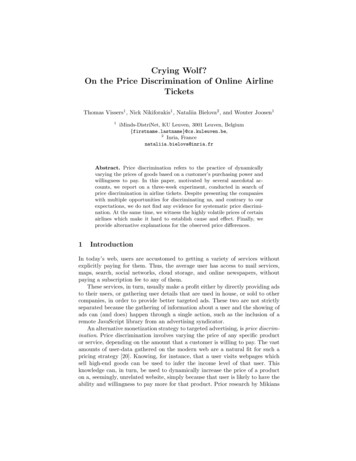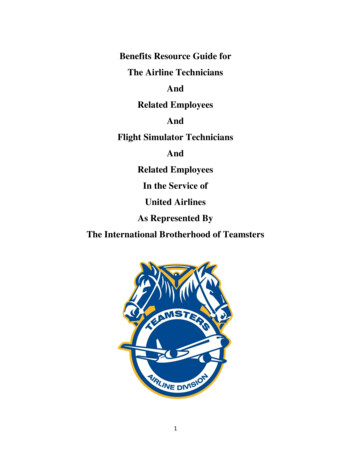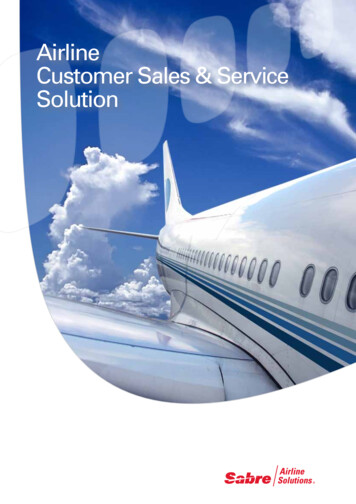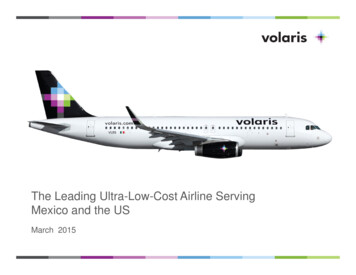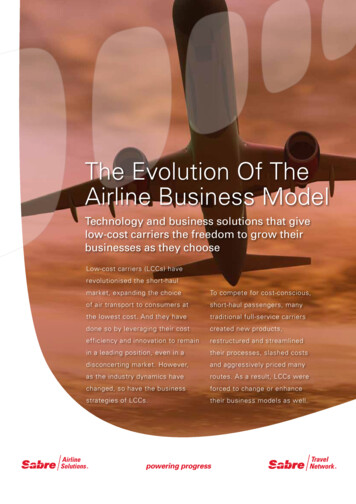
Transcription
The Evolution Of TheAirline Business ModelTechnology and business solutions that givelow-cost carriers the freedom to grow theirbusinesses as they chooseLow-cost carriers (LCCs) haverevolutionised the short-haulmarket, expanding the choiceTo compete for cost-conscious,of air transport to consumers atshort-haul passengers, manythe lowest cost. And they havetraditional full-service carriersdone so by leveraging their costcreated new products,efficiency and innovation to remainrestructured and streamlinedin a leading position, even in atheir processes, slashed costsdisconcerting market. However,and aggressively priced manyas the industry dynamics haveroutes. As a result, LCCs werechanged, so have the businessforced to change or enhancestrategies of LCCs.their business models as well.
Crossing international borders andexperimenting with long-haul segments, Expanding market opportunities suchas increasing international reach andaccessing the corporate segment byparticipating in a GDS.While price remains a key competitivefactor, it is no longer the sole driver oflow-cost carrier business strategies.LCCs now focus on other areas, such asmerchandising, multi-channel strategiesand increasing partnerships. They alsoplace more emphasis on:2 Maintaining low costs while compensatingfor rising costs of fuel and aircraft,With carriers veering from the fundamentallow-cost strategy, it is no wonder that thelow-cost business model has been difficultto define in recent years. The result ofthis shift is the emergence of the “hybrid”business model. This model combines thecost-saving methodologies of a pure lowcost airline with the service, flexibility androute structure of a full-service carrier. Integrating new services into the currentmodel and enhancing customer service,Figure 1 demonstrates this phenomenonof evolving models based on three carriers.
2008NetworkFareStructurePartnershipsfst-Business modellong-haevolutionLow-costcarrierSub-regional network;short-haul, point-to-pointOffers same faresto all customers,handful of faresMix of shortand long-haulInter-regionalflightsDifferencesby channelUses privatefares andrestrictionsUses limitedcodesharingNo codesharingor interliningSales andDistributionDirect sales onlyvia websiteOperationsOperates single aircraftmodel; topquartile in costsInter-regional;connecting Sub-regional network;short-haul, point-to-pointFareStructureOffers same faresto all customers,handful of faresNo codesharingor interliningDiffers fares bycustomer/channel;has restrictionsSome use of codesharingand interliningonnshipvee aelcoorDistributes through GDSMix of aircraft models;mid-range costperformanceSecondquartile in interliningUsesRelationships withthird-party travel agencies/aggregatorscorporationsUses mix ofnarrow- andwide-bodymodelsFull-servicecarrierSouthwestf sholo hDirect sales onlyvia websiteOperationsOperates single aircraftmodel; topquartile in costsgiohtsBusiness modelevolutionMix of shortand long-haulInter-regionalflightsDifferencesby channelUses privatefares andUrestrictionsodUses onships withthird-party travel agencies/aggregatorscorporationsUses mix ofnarrow- andwide-bodymodelseasyJetSecondquartile in egional;connecting flightsDiffers fares byFacil customer/channel;terlrli has restrictionsSome use of codesharingand interliningUsthiragSales andDistributionFigure 1 Characteristicsof three hybrid businessmodels from 2008to 2010.nsshshipvel acorpDistributes through GDSMix of aircraft models;mid-range costperformanceSouthwest3
Invest In Technologythat helps your business grow andsets you freeThe trend toward a hybrid business modelimpacts the requirements for IT systemsand drives the need for a more sophisticatedand flexible technology environment. Thereare many reasons successful hybrid airlineexecutives invest in leading-edge technologywith the right technology partner, such as: Moving to a new passenger servicesystem (PSS) that supports the currentmodel as well as enables future capabilityrequirements, Requiring technology to evolve andsupport the airline’s scale of business, Requiring a provider with deep industryexperience and sophisticated deliverymethodology that meets current andfuture demands, Looking for greater revenue-producingcodeshare and interline partnershipopportunities, Expanding ancillary revenue, Identifying marketing opportunitiesto gain more accurate insight intocustomers’ behaviour patterns and needs.Therefore, as a hybrid carrier, it is crucial toacquire technology that “sets you free” tofocus on your changing business challenges.With the right technology, hybrid carrierscan propel their businesses forward,responding more quickly and effectivelyto changes than ever before.Sabre Airline Solutions and SabreTravel Network technology helps yourbusiness evolve to the next level. Sabre4Travel Network connects sellers withtravelers through the world’s largest travelmarketplace. Our Sabre AirCommerce TMsolution bundles, powered by the Sabre system, deliver flexibility to meet yourairline’s unique needs — growing revenue,increasing reach and gaining valuableinsight. In addition, by providing a portfolioof progressive solutions, Sabre AirlineSolutions ensures that you are properlyequipped to effectively and efficientlyaddress future business issuesas they arise.No other company can provide technologywith the same degree of flexibility to changeand adapt as conditions demand. Based onservice-oriented architecture, our Sabre ASx SM Airline Services Exchange gives youthe flexibility to control, build and utiliseyour own in-house systems and/or thirdparty systems.And for airlines seeking a cost-effectivealternative to an installed on-site system,our Software as a Service offering providespredictable, simplified pricing and equipsairlines with an economical way to accessour comprehensive portfolio of IT solutionswithout the usual added IT infrastructure.With our SaaS offering you can: Significantly reduce total cost ofownership, Simplify your IT operations by lettingus provide the right applications, hostingand maintenance, Focus on what you do best, namelymanaging passengers and flights,because we handle the IT environment,freeing up time and money for you.Today, more than 130 airlines benefit frommore than 400 applications hosted by SabreAirline Solutions.The technological foundation of oursolutions portfolio delivers flexibility backedby years of industry experience, helping youto meet future challenges head on.
Building PowerfulProfitability Strategieswith a complete marketing andplanning solutionLow-cost carriers excel at streamliningoperations and maintaining lower costs.However, to expand beyond the networkand consequently increase the competitivelandscape, a hybrid carrier needs toensure that profit remains high. To do so,airline assets (network, fleet) and revenuemanagement strategies need to be optimised.Our marketing and planning solutionoffers numerous profitability-gainingbenefits including:Decreased revenue dilution and increasedrevenue The revenue managementsolutions you rely on must support thedynamic pricing environment of the hybridcarrier. Revenue benefits are realisedthrough the support of restriction-free, lowfare ticket strategies, advanced forecastingand optimisation methodologies, accurateseasonality mapping and business supportfor both market and route analysis.Choice of processing modes You can rundifferent processing modes based on thedesired level of sophistication in inventorycontrol, such as leg-and-segment-basedserial nesting, O&D-based virtual nestingand O&D-based continuous nesting.Improved competitor insight By consideringcompetitor data — from sources such asQL2, Infare or other third-party vendors— during the analysis process, you canbe confident of the revenue managementdecisions you make.In addition, analysis of competitors’ Webdata can assist with pricing and revenuemanagement, such as using current datafrom competitors’ websites to determinewhether making inventory modificationsin response to their available fares is asound business decision.5
“As an active Sabre AirVision Revenue Manager customer, weare enjoying the benefits of the solution. The recent measuring valuereport highlighted key metrics to our team. It is a great tool to helpus to understand where we are doing well, and also where we needto focus and perhaps change some internal processes. We haveobserved increased productivity and good quality demand forecast.This helps our analyst make optimal decisions on managing ourinventory. We are very happy with the support we receive fromthe Sabre [Airline Solutions] team.”—an Asian hybrid carrierCompetitive revenue management Insteadof using historical data maintained bythe revenue accounting department,competitive revenue managementhelps you optimise the decision-makingprocess by using data from the revenueoptimisation tool. Integration between therevenue optimisation tool and the faremanagement tools enables your revenuemanagement department to perform nearreal-time decisions, with the most relevantcompetitive insight.This integration also enables improvedpricing actions. Provided with not onlyhistorical market trends but also currentand dynamic information, you have accessto future average fares, fare seasonalityand even price sensitivity within the market.And with communication between externalsources such as ATPCO and internalsources, such as a schedules analysis tool,your pricing analysts have access to dataneeded to publish the most competitivefares to support your airline’s position inthe markets it serves.Enhanced network planning You can morereadily decide which markets to serveand how often, and when to fly and whichtype of aircraft you need to assign to aspecific route. Plus, you can stay aheadof the competition through evaluationof the profitability of various schedulingalternatives and the opportunities providedby codeshare and network planning tools.Figure 2 Sabre AirVision Marketing & Planning key capabilities6
Case StudySuccessful North American Carrier ChoosesSabreSonic Customer Sales & ServiceTo Help It GrowBackgroundA North American carrier that boards more than 20 million passengers per year selectedthe SabreSonic CSS solution to power its reservations, departure control functions, inventoryand Internet booking engine.The carrier’s previous reservations system offered limited ability to connect to and interactwith other airline reservations systems and GDSs. While the system supported the carrier’spoint-to-point route and manual processes for managing revenue and fares, it could notsustain the airline’s need to benefit from additional revenue sources by evolving its businessmodel to include codeshare and interline partnerships opportunities. A more sophisticatedsolution was required to effectively support these relationships.Approach TakenReasons for choosing SabreSonic CSS included: Improve revenues through codesharing and partnerships, Provide more flexible ancillary services sales and branded faresfor higher up-selling capabilities, Guarantee an end-to-end customer view of its frequent flyer programme members.ResultsBoth the carrier and Sabre Airline Solutions consider the cutover a success. A majorcontributor to that success was both parties’ understanding of and acting upon the needfor effective project planning as well as commitment to manage the transition.The carrier is confident in having chosen the right technological solution for the nextstage of its evolution.7
“The SabreSonic Customer Sales & Service solution willenable JetBlue to offer greater revenue-producing codeshareand interline partnership opportunities, which will expandnetwork choice for our customers, expand ancillary revenueand marketing opportunities and will help us gain moreinsight into our customers .”—Rick Zeni, vice presidentchange management-passenger service system at JetBlueGrowing Revenue AndEnhancing The CustomerExperiencewith a flexible customer salesand service solutionWhen it comes to meeting ever-changingcustomer expectations, hybrid carrierssignificantly benefit from a customer solutionthat gives them the flexibility to respondefficiently and quickly to their customers’requests. Our offering provides a completeend-to-end customer sales and servicesolution. It delivers powerful distribution,sales and fulfilment capabilities frommerchandising, e-commerce and reservationsto inventory and departure control.Key customer sales and service advantagesinclude:Gain full partnership and expandeddistribution capability You can leverage“traditional” airline partnership features,such as: Complete airline-to-airline connectivity(interline electronic ticketing, codeshares,EDIFACT through check-in and directconnectivity for availability, selling andseat selection), Full support for all alliance requirements.Access real-time customer data at all touchpoints By better understanding your leisuretravellers and buyer preferences, youdeliver a stronger loyalty strategy.This is accomplished in part by: Accessing information on your leisure orcorporate customers, such as preferences,trip history, loyalty information andcustomer service history via a powerfuldata warehouse of customer information,Figure 3 SabreSonic Customer Sales & Service key capabilities8
Identifying and communicating aboutcustomers as well as communicating withcustomers at all touch points of the travelexperience, including hassle-free checkin and consistent service via handhelddevices and self-service kiosks.Manage increased revenue opportunitiesHandle ancillaries within the core hostsystem as well as through the Sabre GDS.Prioritise your marketing efforts Employinga robust, configurable, easy-to-use solutionthat uses airline-specified parameters tocalculate a single customer value score.Leverage your online presence Whetheryou select our Internet booking engineor elect to employ your own, you canfurther increase your online market shareby taking advantage of the tools we provide.For example, the advanced shopping enginecan return hundreds of low-fare options.Also, you can generate additional revenuewith branded fares and inventory control ofancillaries as well as business agreementswith different insurance providers.Our solution gives you the flexibilityto maintain full control of the Internetbooking engine while integrating it withthird-party products.Enhance your reporting methodsPresenting information in the right formatspeeds decision making. Using the latestbusiness intelligence technologies, aset of integrated reports captures yourperformance measurement as well as theeffectiveness of market actions taken. Youcan produce an “at a glance” view of theoverall health of your airline. This graphicalreport aggregates critical performancemetrics and provides updates on a timelybasis (Figure 4).Figure 4 Sabre Executive Dashboard9
balance calculations. Also, crews are betterutilised through improved rostering andpairing. Plus, airport operations are moreefficient through better staffing managementand employee staff management tools.Maintaining The HybridCarrier’s Cost Advantagewith an enterprise view of theairline operationsAs hybrid airlines grow and increase scaleand complexity into their operations, theneed to maintain costs at the lowest levelpossible is a given. Also, the airline’sIT solutions must support changes thataccompany this growth.The IT solutions must continue to manageprocesses efficiently and effectively whilecoping with increasing complexity fromlegal requirements and different regulationsto disruptions and irregular operations.With our enterprise operations solution,you can maintain your cost advantage by:Optimising your operations from planningto execution and expanding efficientlywhen complexity increases You can bettermanage your fuel spend through variablecost-index flight planning and weight-and-Automating processes and improvingdecision making Integration amongsystems is critical to managing complexitywithin airline operations. With our solution,changes made in one system are sent todown-line systems via service-orientedarchitecture to ensure that all teams areworking from the same data. This increasesnot only the quality of data being sharedbut also the effectiveness of the solutions —better data creates better results. With justin-time information capabilities, informationis accessible at the right time in the rightformat to the right operations personnel.Managing disruptions efficientlyIntegration among systems is also criticalduring disruptive events. You can returnto normal operations as soon as possibleby creating multiple scenarios that can beevaluated quickly. With crewmember andpassenger reaccommodation and a swiftrecovery time, you minimise the financialimpact of disruptions and minimisedowntime impact.Figure 5 Sabre AirCentre Enterprise Operations key capabilities10
Case StudyAPAC carrier choses a number of SabreAirCentre applications to support its growthand increased complexity.BackgroundA low-cost carrier based in APAC experienced a rapid growth both domestically andinternationally. As a matter of fact, its fleet increased from 15 aircrafts to 70 within aseven-year time period.With that growth, the airline faced a number of challenges: Which applications to consider since it could not support continued growth withits current non-scalable applications, How to continue to grow and increase the size of the fleet and the crews, whilemaintaining low cost, How to ensure the airline followed the domestic and international crew regulationsas its number of crewmembers increased.Approach Taken The carrier invested in a number of applications that would support the automation of itsprocesses in the operational areas of crew, flight planning, reaccomodation and flight control. It chose from the beginning a system that answered its high requirements for scalabilityand flexibility to support its aggressive growth plans. The carrier acquired a regulatory system to ensure it followed all required regulations.Results The carrier managed to handle the growth it was experiencing over the years. It is todayrunning multiple airlines on a single IT platform. The Sabre AirCentre crew and flight operations solutions enabled the airline to automate anumber of processes without increasing the number of people in the operational area.11
beyond the current network or beyond thetraditional leisure traveller segment, salesopportunities are maximised.Increasing ReachBeyond The Networkby selling through multiple channelsHistorically, low-cost carriers have typicallyfocused on the direct distribution channel,capturing customers who purchase fromtheir websites in order to maintain their lowcost structure. However, LCCs that move tothe hybrid business model look beyond theWeb for new ways to generate additionalrevenue. A multi-channel distributionstrategy provides customers access notonly over the Web and through callcentres but also through GDSs or onlinetravel agencies. By expanding your reachOur distribution and marketing solutionhelps you:Attain distribution balance The multichannel distribution strategy offers a varietyof benefits. Most important is the ability toreach more consumers through additionalavenues. It is well known that the majorityof consumers access multiple channels toshop and book travel. You can capture themaximum number of travellers and increaseyour market share by offering your productthrough multiple distribution methods— pulling in the travellers who prefer tochoose from among multiple channelsbased on the purpose of the trip.Figure 6 Understanding a customer’s profile and purchasing patterns, together withMIDT and TCN data, is a vital part of a successful d
changed, so have the business strategies of LCCs. To compete for cost-conscious, short-haul passengers, many traditional full-service carriers created new products, restructured and streamlined their processes, slashed costs and aggressively priced many routes. As a result, LCCs were forced to change or enhance their business models as well.
